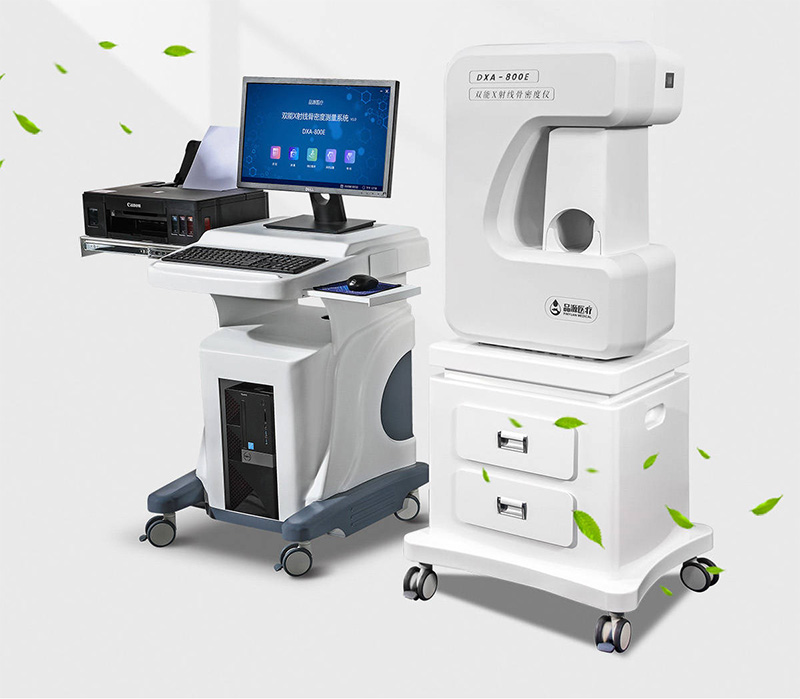Today, as health management is increasingly valued, bone density testing has become an important means to assess bone health, especially for high-risk groups of osteoporosis such as middle-aged and elderly people and postmenopausal women, this test is indispensable. However, when faced with the dense data and professional terms on the test report, many people feel confused. Today, we will take you through an in-depth interpretation of bone density test reports to help you accurately grasp your own bone health status.
The principle of bone density testing
Bone mineral density, also known as bone mineral density, is an important indicator of bone strength. At present, the most commonly used method for bone mineral density detection in clinical practice is dual-energy X-ray absorptiometry (DXA). It precisely measures the content of minerals in bones by emitting X-rays of two different energies, which pass through bones and soft tissues, based on the differences in the absorption of X-rays by different tissues. This method has the advantages of low radiation dose, short detection time and accurate results, and is internationally recognized as the “gold standard” for bone density testing.
Interpretation of Key Indicators in the report
When obtaining a bone density test report, there are two core indicators that need to be given special attention: the T value and the Z value.
T value: Comparison with healthy young people
The T value is obtained by comparing the bone density of the person being tested with the average bone density of normal and healthy young people of the same gender, with the unit of standard deviation (SD). It reflects the degree of deviation of the bone density of the tester from that of healthy young people and is an important basis for judging osteoporosis.
When the T value is ≥ -1.0 SD, the bone mineral density is normal, indicating good bone health and a low risk of osteoporosis.
When -2.5SD <T value < -1.0SD, bone mass decreases, indicating a decline in the mineral content in the bones. Although it has not yet reached the level of osteoporosis, it is already in a “warning state” and requires attention. Timely measures should be taken to prevent further bone loss.
When the T value is ≤ -2.5SD, osteoporosis can be diagnosed. At this time, the bones become fragile and the risk of fractures significantly increases. It is necessary to seek medical attention actively and receive standardized treatment under the guidance of a doctor.
If the T value is ≤ -2.5SD and accompanied by brittle fractures (i.e., fractures occurring under minor external forces), it is diagnosed as severe osteoporosis, which is a relatively serious bone disease and poses a significant threat to the quality of life and health safety of patients.
Z value: Compared with peers
The Z value is obtained by comparing the bone density of the person being tested with the average bone density of the same gender and age group. It is mainly used for children, pregnant women and people with certain diseases that affect bone metabolism, to help determine whether their bone density is consistent with that of their peers.
When the Z value is ≥ -2.0 SD, the bone mineral density is within the normal range of peers, indicating that the bone development or health status is comparable to that of peers.
When the Z value is less than -2.0 SD, it indicates that the bone density is lower than the average level of people of the same age. Further examination is needed to clarify the causes of the decreased bone density, such as whether there is nutritional deficiency, endocrine diseases, etc., and targeted treatment should be carried out.
Understand the report and respond scientifically
After understanding the various indicators of the bone density test report, in the face of different test results, we should take corresponding scientific countermeasures:
Normal bone density: Continue to maintain a healthy lifestyle, such as having a balanced diet and consuming more foods rich in calcium and vitamin D (such as milk, fish, nuts, etc.); Persisting in moderate exercise, such as walking, jogging, Tai Chi, etc., is helpful for maintaining bone strength. Avoid bad habits such as smoking and excessive drinking to reduce damage to bone health.
Reduced bone mass: In addition to maintaining a healthy lifestyle, calcium and vitamin D can be appropriately supplemented under the guidance of a doctor to increase bone mass. At the same time, regularly recheck bone density and closely monitor changes in bone health.
Osteoporosis: It is essential to seek medical attention actively and receive standardized treatment under the professional guidance of a doctor. The treatment plan usually includes drug therapy (such as bisphosphonate drugs, calcitonin, etc.), lifestyle intervention, etc. In addition, it is necessary to pay attention to preventing falls and reducing the risk of fractures. For example, keep the living environment clean and well-lit, and use assistive devices (such as crutches and walking AIDS) when necessary.
A bone density test report is like a “physical examination sheet” for bone health. By accurately interpreting the various indicators in the report, we can promptly understand our own bone health status and take scientific and reasonable measures for prevention and treatment. No matter what the test results are, maintaining a healthy lifestyle is always the foundation for maintaining bone health. It is recommended that everyone undergo regular bone density tests, especially for high-risk groups, to achieve early detection and early intervention, safeguard bone health and enjoy a good life.
Post time: Apr-22-2025



